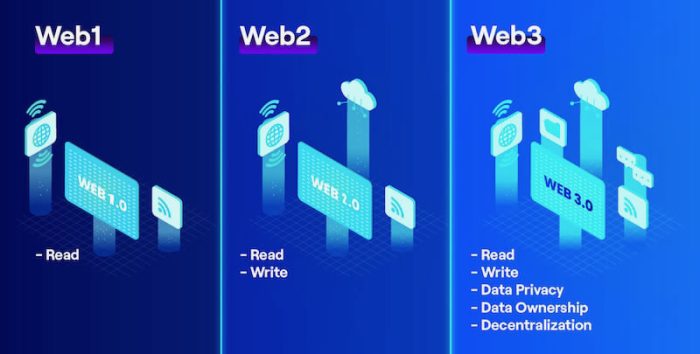https://nasacademy.com/blog/article/what-is-web-3
Web 3 or as some may call it “web3.0” or “web3”- is a term that is doing rounds across the crypto industry these days. Blockchain technology is impacting every aspect of our daily lives. In this post, we shall discuss how blockchains are transforming the internet as we know of. Since the evolution of the internet, only a handful of companies are controlling the entire ecosystem. These companies are Facebook, Google, Netflix, Amazon etc. But what is web 3 and how does it help one to reduce the dependency on big tech a.k.a. FAANG (Facebook, Apple, Amazon, Netflix, Google)?

For understanding web 3, we will have to take it from the top. We need to understand what web 1 and web 2 was all about. While we are at it, we would also try to understand the shortcomings of each version of the web to establish the requirement for web 3. So, let us dive into the history of the internet.
For an average household, the internet came into existence about 30 years ago. For our generation Z readers, it was not what we see today. Not even close. Think of the internet as a massive encyclopedia put on a common server back then. All you could do is access this information in the form of static web pages and read it.
There was no way you could interact with it. All you could do is ‘read–only‘. Advertisements that form the core of the business models of new age tech companies, did not exist back then. Why? Because what good is an ad that you cannot click. This era continued till the early 2000s.
With the advancement in web based technologies, developers paved the way for people to interact with the web pages. Not only could you access a piece of content, but also share your opinion on it in the form of text, image or some native tools like ‘Like’, ‘Share’ etc. This could easily be termed as an era of Social Media.
The content generation roles moved from a few individuals to almost everyone who had access to the internet. The rise of UGC or user generated content led to a paradigm shift in the business models of internet companies.
Companies and individuals came up with newer, innovative ways to earn revenue. For example, someone could now teach something on YouTube and earn money out of it. If a person had significant influence over a group of people, they could now tie up with brands and get paid to promote their product.

As the internet penetrated deeper into tier 2 and tier 3 cities in large countries, the tech businesses boomed and gave everyone an equal shot to fame and glory.
Another stark difference between web 2 and web 1 was user experience (UX). Web 2 companies nailed the art of creating beautiful user journeys that made our online experience absolutely seamless.
Apart from that internet usage on mobile phones saw a surge as compared to desktop and laptop during the web 1 era. This shift gave the internet a much needed mobility and paved the way for mass adoption.
As per January earnings report, Facebook had 2.9 billion people flocking on their platform every single month (source). For a perspective, that’s roughly 40% of the global population.
Are you thinking that how did we end up with issues all of a sudden? Web 2 was everything the human race needed. An unbiased platform to voice your opinions, a smart way to monetize your skills, a place to share your thoughts with the world and who knows, maybe find love for some.

Well, that is just one side of the story. Let us explore the other side of it:
Every action of yours is currently being tracked on social media. This data is then fed to supercomputers which predict the best possible content to keep you hooked on to their platform for a longer duration.
When you spend countless hours on your favorite social media platform, these companies make money. Let’s find out how.
You see, whatever interactions you have on these platforms translates into a massive amount of data, which gets stored on their servers.
Think of it like this; you open Instagram and start scrolling aimlessly. A photo of your crush pops up, and you ‘like (upvote)’ it. Next up, your cringe neighbor’s post shows up prompting you to select the “Show less like this” option. Unknowingly, you are explicitly feeding data into the platform.
It’s also a common practice for brands to track the time that you spend on various posts. Here’s an example: We log into multiple applications using the Google or Facebook credentials out of laziness to sign-up. Now, they get access to more data e.g. your geographical location, eating habits, vacation goals, and a lot more (depending on the apps you use).
But how do they use this data?
They go to the brands and say, “hey, we’ve got a list of customers who are in their twenties, love cute puppy videos, spend the weekend cooking, shop online at least 3 times a week, post their selfies frequently, etc. and would be ideal targets for your product.
Pay us so that we can show your ad to them”.
So user (your) data is a product that is sold to brands, who use it to create targeted ads/content.
If something is being given away for free, you are the product.
Web 2 is controlled by big tech companies like Google, Apple, Twitter and Facebook. Over the past few years these companies have become extremely powerful due to this. For example, these platforms recently banned Donald Trump from their respective platforms. This means authority to pull the plug lies in the hands of a centralized entity.
Second risk associated with centralization is outage. A few months ago Facebook suffered the biggest outage in history where all the platforms were down for more than 8 hours.

Now that we are aware of the problems arising out of web 2, we can appreciate the importance and need of web 3. The idea of web 3 was conceived with the advent of the Blockchain technology.
Web 3 inherits it’s properties from the very fundamentals of blockchain i.e. decentralization. In web 3 realm, your data is not stored in a centralized server. Rather, it is stored in your own custody.
Here’s an example of how this could work:
Imagine that you post reels on an Instagram like platform. Instead of just posting and forgetting about them, all of these reels are NFTs issued in your name. Now you could take these reels to some other platform if need be. You could also sell the ownership of these reels to some brands. You could also raise money against these reels to produce more. We are only limited by our imagination.
Bottom line: If you own your data, you can monetize it as you want. You could also share a part of the revenue with the platform for enabling this monetization. This is how web 3 has the potential of turning the tables.

With that being said, not all are rainbows and colours. There is a significant amount of development which is required for web 3 to become mainstream. A few issues that might become an hindrance in this journey are as follows:
While owning your own data seems like a utopian idea, the user interface to do so is not up to the web 2 levels currently. Often, you have to create a wallet, remember seed phrases and store your assets. No central authority also means that no one is responsible if you lose your keys and hence the data.
While we are ready to own our data, who is going to host it in that case? Companies like Facebook and Amazon have huge facilities (servers) that store enormous amounts of data generated by us. If these companies are not making the same amount of money, how is this storage model going to sustain?
Censorship resistance has always been a raunchy idea for mankind. However, what if things go out of hands? Who is going to call the shots? All these questions are yet to be solved. However it will be interesting to watch this space.

With growing concerns over data privacy each day, web 3 innovations are going to come up faster than ever. It is important that you equip yourself with a basic understanding of this space as it is going to impact that way we work.
For the first time ever, top experts have come together with Nas Academy to form a web3 learning community – and you’re invited!
Whether you’re launching an NFT project, investing in Bitcoin or NFTs, or are curious about how web3 works, you’ll discover that “community” is the foundation of the web3 space. And now, you can join a vibrant and supportive community full of web3 enthusiasts like yourself.
This community offers a safe space to network, learn, and collaborate with some of the most innovative thinkers around the world. On top of that, we’ve pooled all our resources to give you access to thousands of dollars worth of Nas Academy resources (including our best-rated classes) all under 1 subscription.
By subscribing to the Nas Academy Web3 Community, you’ll also be invited to join exclusive events and workshops with the world’s leading experts – an opportunity that you won’t easily find anywhere else. So, if you’re looking to learn more and discuss web3 with others who share your interests, subscribe today and join the movement that’s changing the Internet.
By Admin Nas Academy
By Team Nas Academy